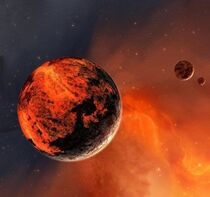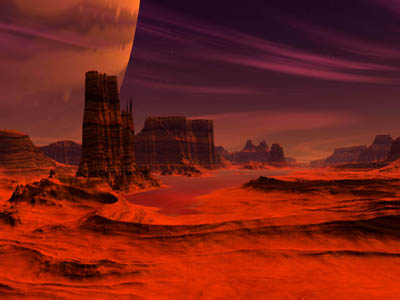Avronis V

| |
| Avronis V | |
|---|---|
| Stellar Cartography | |
| Region | Romulan Star Empire |
| Sector | Venturius sector |
| System | Avronis System |
| Sun(s) | AB67, yellow star |
| Moon(s) | One, with moon base |
| Class | Class L |
| Physical | |
| Diameter | 4212 miles / 6779 km |
| Atmosphere | Low oxygen, partially breathable |
| Hydrosphere | No bodies of water |
| Climate | Arid, windy, extreme temperatures |
| Gravity | 1.2 times Earth standard |
| Primary terrain | No vegetation. Various rock formations. |
| Points of interest | D'ramis Gorge, southern hemisphere |
| Length of Day | 14 hours |
| Length of Year | 187 days |
| Native species | none native |
| Other species | Romulan |
| Societal | |
| Official Language | none |
| Population | none known |
| Technological Classification | ruins indicate: J or higher |
| Major cities | none left, evidence of extensive ruins |
| Imports | none |
| Exports | none |
| Affiliation | Romulan Star Empire |
| Government | none |
Planetary Location
Location:Beta Quadrant, within Romulan space. Avronis lies on the outskirts of the Trinity Sector, between the Agurtha colony and the nebula that separates Romulan space from the Eryscyne alliance.
Distance to Known Landmark: Closest is Agurtha Colony, three days out at warp 6. Avronis is less than six days away from the far border of Eryscyne territory, but only if one can successfully navigate the nebula. It is easy to reach with slipstream drive.
Nearby Locations of Interest: There is a Romulan security outpost at the edge of the nebula that monitors anything that might come out of the nebula. The outpost is labeled on star charts as ‘R146.’ It is a manned listening station with a small crew compliment. The outpost orbits a stationary planetoid outside the nebula. It is an older design that is in need of upgrades and repairs, but still holds defensive and offensive capabilities, including a half dozen small fighter/scout ships that can be called to action if the need arises.
Planetary Classification:
Classification: Class L, Terrestrial, partially breathable atmosphere.
Atmospheric Analysis: Avronis V has a low oxygen saturation in its atmosphere, and high levels of CO2. Humanoids of copper-based blood types can breathe the atmosphere for 4-6 hours before suffering dizziness, fatigue and nausea. Humanoids of iron or cobalt based blood types can only withstand it for 1-2 hours. Acclimatization for colonization (similar to acclimatization for great altitude in humans) is only possible for copper-based blood types. Iron and cobalt based blood types would need pressure domes and breathing equipment unless extensive terraforming is completed. [This is not taking into account the theta radiation]
Radiation Analysis: Avronis V is an antimatter waste dump planet, full of decaying antimatter from approx 2120-2280 era (Enterprise-pre original Trek timeline). There has been no previous cleaning effort on this planet. Theta radiation is strongest at the source of the dumping – a large gorge in the southern hemisphere – but it has suffused the entire atmosphere. At the source radiation poisoning will affect an unprotected person in 30 minutes or less. On any other area save the southern gorge, radiation poisoning will effect an unprotected person in 2-3 hours.
Simming information
Atmospheric sickness for those not in environmental suits would be very similar to altitude sickness. The progression of altitude sickness starts with a feeling of ‘hangover’ progresses to symptoms of headache, fatigue, stomach illness, dizziness, ‘pins and needles’ feeling in extremities, and sleep disturbance. These symptoms are worsened by high physical exertion. With extended exposure to the Avronis atmosphere, hyperventilation occurs, followed by pulmonary edema (fluid in the lungs) [Symptoms similar to bronchitis, persistent dry cough, fever, shortness of breath even when resting.] and cerebral edema (swelling of the brain) [Headache that does not respond to analgesics, unsteady gait, gradual loss of consciousness, increased nausea, retinal hemorrhage]
Satellites/Space Stations
Avronis V has one (unnamed) moon, it is glaciated and without atmosphere. There is an environmentally-domed Romulan moon base on this sattelite. There are no other space stations in the system or surrounding area
As of 239109.01 the moon base had its sensors upgraded so it was no longer 'cycle blind' to the planet's surface as the moon rotated. These upgrades were non-classified recommendations from Lieutenant Piers Ambrose on behalf of the USS Columbia to the moon bases' administrator Vhril tr'Lleodah. The purpose of these upgrades was to make the Romulan military aware of illegal alien and Tal Shiar activities on the planet. The parts for the upgrades were delivered to the moon base before the Columbia left orbit.
Land/Water Ratio
75%/25% Avronis V has no oceans nor freshwater bodies. The water that does not immediately evaporate in the tenuous atmosphere is stored in underground reservoirs, or the polar ice caps.
Avronis V shows signs of having oceans at one point, but they have all gone dry, leaving the planet a barren wasteland of hills and valleys. There are two large mountain ranges, both running north-south on the western hemisphere of the planet. These mountains reach a great altitude, and store much of the remaining water on the planet in snow caps. There is also one massive gorge in the southern hemisphere, running east-west, this is where the majority of decaying antimatter has been dumped.
Detailed scans indicate that there is a vast cave system under the high-ground in the Eastern hemisphere, much of which appears to be shaped by intelligent lifeforms. It is difficult to determine exactly what these cave systems look like or what all they hold without actually getting into them due to the interference from the theta radiation.
Mineralogy: Avronis V has large deposits of Magnalite, Quartzite, Nickel and Copper, with smaller amounts of Irithium and Manganese. As none of these minerals holds any great value to the Romulan empire, the planet has never been tagged for any substantial mining.
Climate
Avronis V tends towards extremes in temperature owing to its limited atmosphere.
The majority of the planet is barren and prone to high winds and electrical storms. Near the equator temperatures range from 160-170F [71-77C] in the daytime, falling to 80-90F [27-32C] degrees in the evening. In the temperate zones the range is 130-140F [54-60C]/20-30F [neg1-neg7C] and in the northern and southern hemispheres the temperature range is 50-60F [10-15C]/neg30-neg20F [neg34-neg38C]. Wind and dust storms can reach speeds of 120 MPH [193KmPH], and static electricity during such storms often interferes with equipment.
Native Life
Avronis V has evidence of varied life in its distant past, both sentient and non-sentient. Archeological evidence of a variety of plant and animal life litters the rocks on the planet’s surface.
Currently Avronis V appears devoid of life, however it does support a wide variety of bacteria, as well as fungal colonies, mold and some low invertebrate life forms in the cavern structures.
No avian, reptilian, amphibian or mammalian life forms have ever been reported on Avronis in modern scans.
History
Little is known about the history of Avronis V. Much of this is due to its location inside Romulan territory. It is obvious the Romulans cared little for the history of the planet, using it as a garbage dump for spent antimatter. What research has been done indicates that at one point Avronis was a Class M planet, sustaining a vibrant ecosystem and a wide variety of animal life. It is generally accepted that Avronis was home to an intelligent species, which made their homes in the cave systems of the eastern hemisphere (likely a continent at the time).
By the time the Romulan Star Empire was exploring the area, Avronis was deserted. There is no record or evidence of any altercation between the Avronis natives and an outside power. By the time the Romulans discovered the planet, it was uninhabited and inhospitable. It is estimated that the Avronis natives flourished between 2000-2500 years ago. What happened to them is unknown.
After the explosion of the Hobus Star, the Romulan Empire officially halted the dumping of antimatter waste as a show of political goodwill. This was most certainly done to get aid from outside governments, including the Federation. In reality, antimatter dumping only halted on the planets that were close enough to Federation space to be monitored. As Avronis is on the far side of Romulan territory, the policy has always been ‘we don’t care; don’t get caught.’
Mission Data
In the Things We May Find mission, the USS Columbia discovered several key bits of information on Avronis V:
1. Avronis is still being used as an Antimatter waste dump by independent freighters 2. Avronis bears extensive archaeological ruins, including ruins that appear to be from the Iconian civilization 3. There was a group of Tal Shiar agents working on the planet, unbeknownst to the Romulan government (or the waste dumpers) 4. These Tal Shiar agents were working with an unknown alien race. It appeared they were trying to restart the Iconian equipment 5. The Columbia removed the Tal Shiar from the planet by force in order to prevent the gateway from being opened 6. The Columbia worked with the moon base administrator to strengthen the moon base's sensors 7. As the Tal Shiar and the unknown aliens presented an equal threat to the Romulan military as it did to the Columbia, no inquiries were made on what happened on the planet's surface.
